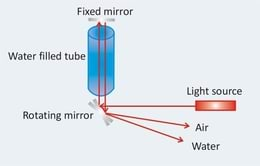Foucault built his setup in the Observatory in Paris. He rotated a mirror (with help of a steam engine available then!). The mirror turned with a speed of 24.000 rotations per minute!
He shined a light source on the mirror. The beam went up through a tube and reflected onto a fixed mirror above the tube. After reflecting down onto the rotating mirror again (which by now had turned a little further), the light came back a little below the source it originated from (where it says ‘air’ in the figure).
Foucault then repeated his experiment, but filled the tube now with water. If the speed of light is faster in water than it was in the air-filled tube, the light would return faster to the rotating mirror than before (which would have rotated less) and the reflected beam would come out above the spot where the beam through air came out.
However, the experiment showed the reflected beam through water came out below the spot where the beam through air came out. This formed irrefutable evidence that the speed of light in water is (SLOWER/FASTER) than the speed of light in air!
Foucault’s experiment didn’t allow any escape to Newton’s particle theory of light… It shows perfectly how a brilliant theory, like Newton’s, can get into trouble by predicting something (such as a faster speed of light in solids) that can’t be verified experimentally. This is something typical in science. A physicist like Newton who was successful with his mechanics, turned out to be unsuccessful with his ‘mechanics of light’.
It was clear that light doesn’t merely follow Newton’s mechanics of particles. Could it be true that light was rather a wave?
